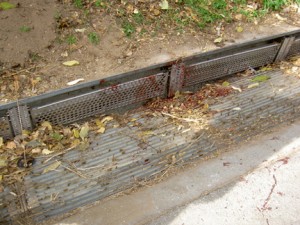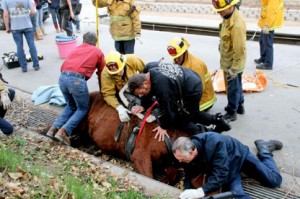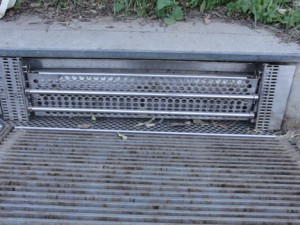L.A. Street Tragedy Results in Mare’s Death
By Paula Parisi March 24, 2011When Bert Bonnett turns 101 on February 19, it’ll be without his beloved mare Cassie. Bonnett and the Missouri Foxtrotter were a regular presence in the Los Angeles equestrian community, where large trail rides to celebrate his birthday have become the stuff of legend. Cassie was euthanized on Dec. 6, following a tragic accident in Shadow Hills in which she was run off the road by a reckless driver. Within a month, her death triggered a municipal initiative to improve the safety of storm drains that many say will be a worthy legacy for the game little mount.
By now, most local horse owners have heard how Bonnett and Cassie were headed home from Corral 20’s Ho-Ho-Ho Christmas caroling ride on Dec. 4 when a reckless driver ran them off the road, sending Cassie skidding into a storm drain that shackled and lacerated her legs. None of the riders accompanying Bonnett was able to get a license plate number or other identifying information on the vehicle, which sped from the scene of the accident, on Wheatland Ave.
The driver, who remains at large, did not heed California Vehicle Code 21759, which states, “The driver of any vehicle approaching any horse drawn vehicle, any ridden animal, or any livestock shall exercise proper control of his vehicle and shall reduce speed or stop as may appear necessary or as may be signaled…”
Cassie, who attempted to sidestep the perceived danger of the rushing vehicle, stepped into drain, which was obscured by leaves and tilted at a 15-degree angle toward the curb. The metal horse shoe on the slanted steel grate was “like greased lightning,” said Hansen Dam Advisory Committee chairman Terry Kaiser, who has become the major force in getting the city to retrofit 5,000 drains for the safety of riders, joggers, bicyclists and small children and animals.
Although there are some 40,000 storm drains in Los Angeles County, not all of them are configured like the one that trapped Cassie, which had perpendicular grates that were wide enough for her hooves and legs to push through and contained sharp-edged metal on the inside. Kaiser said the City of Los Angeles has been remarkably conscientious in responding to the tragedy, sending Adel Hagekhalil, assistant director in the Department of Public Works Bureau of Sanitation, and Alfredo Magallanes, a sanitary engineer with the Watershed Protection Division, to meet with concerned citizens on three separate occasions.
As part of the retrofitting effort, the City is welding over the drains’ solid steel bars so that a horse’s foot can’t slip through. In addition, the sharp-edged interior parts are being rounded-off, and reflective white sticks called delineators are being planted curbside to signal the location of storm drains. Kaiser credits District 2 Councilman Paul Krekorian and his aide Mary Benson with helping to facilitate good communications with the city, but said that’s only half the battle.
In a situation that says a lot about the oddities of regional rule-making, the county is responsible for the part of the drain that is flush with the ground, while the city is responsible for managing the portion that extends up at the curb. As a result of a lawsuit against the city by the county, which determined that too much trash was running off into the L.A. River and the ocean, the city undertook the grating initiative. Prior to that, Kaiser said the open drains were less of a safety threat, and that horses and joggers who previously slid into them were able to extricate themselves without becoming trapped. (Although he said he recalled one other instance of a horse breaking a leg and having to be euthanized.)

The drain just after the accident and prior to the city's retrofitting. (Photos courtesy of Corral 20)
Due to the severity of the accident with Cassie, it is a miracle that Bonnett emerged unharmed. He said that when she went down, the mare was very still until he had a chance to extricate himself from the saddle, at which point she began thrashing to free herself. Bonnett feels certain she did this with his safety in mind. Los Angeles Fire Department personnel were on the scene within minutes, joined by three veterinarians. Thus began a five-hour ordeal to save the horse, who was immediately sedated. She was removed from the grate via pulley at about 3:30 p.m. with severely lacerated legs. X-rays done on-site revealed the mare had a ruptured tendon, but no bone breakage.
By 7:30 p.m. Cassie had been moved to a neighbor’s barn, her legs bandaged and booted. The next morning she was transported to Humphrey, Giacopuzzi & Associates Equine
Hospital in Somis, where she underwent surgery. But by Dec. 6 it was determined that the damage to her hind legs was so severe as to prevent a satisfactory recovery and future quality of life, so the decision was made to euthanize her.
Bonnett—spry but frail—has been trying out other mounts, including Cassie’s brother, who he deemed too large for his barely 5-foot-tall frame. He has yet to find a horse that suits him like the chestnut mare he raised from a two month old and saddle-broke himself when he was still a whippersnapper in his 70s.
“When we go on trail rides, we may have six to a dozen horses that Bert broke for us,” said Corral 20 president Randy Hammock, who includes his own mount, Pepe, in that group. Bonnett is hoping to be remounted in time for his 101st birthday ride. At the Shadow Hills ranch Bonnett purchased 76 years ago, he and his wife, Bari, live with a couple of her horses and donkeys.
Nicole Walther, a neighbor of the couple’s, said the community is concerned about the influx of people to the area in search of the rural lifestyle, but who maintain urban habits and a lack of consideration in sharing the road with horses.
Kaiser said he is in “the very beginning of the process” of getting a safety dialogue going with the county, an effort that will include educational outreach on road safety issues as they pertain to drivers and horses.

Bert Bonnet and his mare, Cassie, in happier days, on the beach in Moro Bay. (Photo courtesy of Corral 20)
Short URL: https://theequestriannews.com/?p=243





